


The English artist Thomas Gainsborough excelled both in portraiture and landscape, though he is best remembered for his individual portraits and informal groups of high society. One of his famous works, Mr and Mrs Andrews, was painted early on in his career, but the bulk of his paintings belong to his stay at the fashionable resort of Bath, beginning in 1760. On moving to London in 1774 he became a favourite at court, producing portraits of the king and queen, and spending some time on royal commissions at Windsor. His work was influenced by the French rococo artists - such as Watteau and Boucher - and his later portraits owed something to the more formal manner of the Flemish painter Van Dyck. He produced portraits in order to make a good living, but he much preferred to paint landscapes. In these he followed the Dutch example, taking his subjects straight from nature, and he was clearly influenced by the work of the Flemish master Peter Paul Rubens. His portraits included The Blue Boy and those of Samuel Johnson and Edmund Burke. His most notable landscapes were The Harvest Wagon and The Market Cart. Among his so-called “fancy pictures” is the whimsical The Cottage Girl with Dog and Pitcher, reminiscent of works by the Spanish artist Bartolomé Murillo. His work influenced, among others, the English painters Turner and Constable.
THOMAS GAINSBOROUGH 1727 - 1788 (G2, G3a, G3b)
Acknowledgements
Gainsborough: Self-Portrait – National Portrait Gallery, London; Mr and Mrs Andrews – National Gallery, London; Pitt the Younger – The Iveagh Bequest, Kenwood House, London; Miss Montagu – Chrysler Museum of Art, Norfolk, Virginia; Portrait of a Lady in Blue – Hermitage Museum, St. Petersburg; Mrs Sarah Siddons – National Gallery, London; Cottage Girl with dog and pitcher – National Gallery of Ireland, Dublin; Painter’s daughters chasing a butterfly – National Gallery, London; Pool in the Woods – Borough Council Museum, Ipswich, England; The Blue Boy - Huntington Library and Art Gallery, San Marino, CA. Nash: after the English portrait painter William Hoare (1707-1792), c1761 – National Portrait Gallery, London. Pump Room: by the English artist Humphry Repton (1752-1818), 1784 – Victoria Art Gallery, Bath, Somerset, England. Wilson: Dolbardarn Castle – Nationall Museum Wales, Cardiff; Cader Idris – Tate Gallery London; The Thames near Marble Hill – Marble Hill House, Twickenham, London. Cozens: View of Vesuvius and Somma – Ashmolean Museum, Oxford; Shepherd’s Hut between Naples and Portici – Victoria and Albert Museum, London; Ruined Fort near Salerno – Courtauld Institute, London; Lake Nemi – Fitzwilliam Museum, University of Cambridge, England.
G3a-1760-1783-G3a-1760-1783-G3a-1760-1783-G3a-1760-1783-G3a-1760-1783-G3a
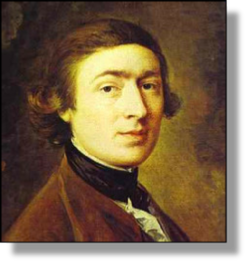 xxxxxThe career of the English painter Thomas Gainsborough took off with a vengeance soon after he settled down in the fashionable resort of Bath in 1760. Within a few years he was one of the country’s best known and admired portrait artists, rivaling the great English painter Joshua Reynolds for his flattering, elegant portrayal of members of the aristocracy - often painted in informal, family groups known as “conversation pieces”. He was also an accomplished landscape artist, but his talent in that direction was not fully appreciated during his lifetime.
xxxxxThe career of the English painter Thomas Gainsborough took off with a vengeance soon after he settled down in the fashionable resort of Bath in 1760. Within a few years he was one of the country’s best known and admired portrait artists, rivaling the great English painter Joshua Reynolds for his flattering, elegant portrayal of members of the aristocracy - often painted in informal, family groups known as “conversation pieces”. He was also an accomplished landscape artist, but his talent in that direction was not fully appreciated during his lifetime.
xxxxxHe was born in Sudbury, Suffolk, the son of a cloth merchant, and attended the local grammar school. Here his artistic talent was quickly recognised, and at the age of 13 he was sent to London to work at St. Martin’s Lane Academy under the tutelage of the French painter and engraver Hubert Gravelot (1699-1773). A pupil of the French artist François Boucher, it was Gravelot who introduced him to the light-hearted rococo style which was to feature in much of his work. In 1745 he opened up his own studio at Hatton Gardens, concentrating on landscapes. He received a number of commissions - probably due to the help of William Hogarth - but, to make ends meet, he also had to turn his hand to copying and restoration work. It was doubtless in this employment that he worked on landscapes by 17th century Dutch artists, like Jacob Ruisdael, and came to value their direct observation of nature. On the death of his father in 1748 he returned to 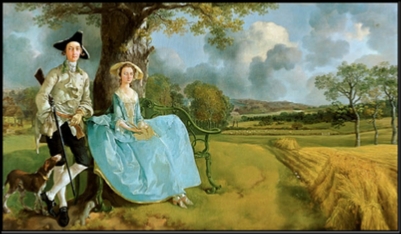 Suffolk and worked at Sudbury and Ipswich for the next eleven years. Here he began to make a name for himself as a portrait artist, but there was not a great deal of money around and his output was somewhat modest. We are told that he could only charge 8 guineas for a “head”, and 15 for a “half-length” portrait. Nonetheless to this period belongs one of his masterpieces, Mr and Mrs Andrews (illustrated), completed around 1749 and now in the National Gallery, London.
Suffolk and worked at Sudbury and Ipswich for the next eleven years. Here he began to make a name for himself as a portrait artist, but there was not a great deal of money around and his output was somewhat modest. We are told that he could only charge 8 guineas for a “head”, and 15 for a “half-length” portrait. Nonetheless to this period belongs one of his masterpieces, Mr and Mrs Andrews (illustrated), completed around 1749 and now in the National Gallery, London.
xxxxxA marked change in his fortunes came when he moved to Bath in 1760, then at the height of its popularity as a spa for “taking the water”, and the place where anybody who was anybody felt they had to be seen. Such was the demand for his graceful family “snapshots” in high society, or portraits of men of distinction and ladies of fashion, that within six years he was able to move to a highly desirable residence near to the Royal Crescent. He mixed in musical and theatrical circles, and it was from here he found time to make visits to country estates in the west country. It was at the Earl of Pembroke’s country home at Wilton, Wiltshire, for example, that he saw a fine collection of portraits by Van Dyke and was clearly influenced by the Flemish master’s elegance and more formal style. And from Bath he also made frequent visits to London. Here he was made a founder member of the Royal Academy of Arts - established by his rival Joshua Reynolds in 1768 - and soon became a court favourite. He moved to the capital in 1774, and was invited to paint portraits of both the king and queen consort, Charlotte Sophia. In the early 1780s he spent some time at Windsor, working on royal commissions. Apart from royalty, his sitters included the actor David Garrick and the actress Sarah Siddons, the writer Samuel Johnson, the politician Edmund Burke, and Elizabeth Ann Linley, the wife of the dramatist Richard Brinsley Sheridan.
Including:
Richard “Beau” Nash,
Richard Wilson and
John Robert Cozens

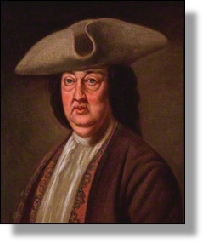 xxxxxTwo years after Gainsborough moved to Bath, the death occurred of the English dandy Richard “Beau” Nash (1674-1762). He was the man who was largely responsible for making Bath the fashionable spa resort it came to be in the first half of the 18th century. He arrived in Bath in 1703 when the whole city was totally run down, but had nevertheless received the royal stamp of approval the previous year by a visit of Queen Anne. Full of charm and swagger, foppishly attired, and with an extraordinary flair for organisation, he quickly realised the city’s potential. He became the Master of Ceremonies for this scruffy centre the following year, and swiftly set about making the city more respectable, promoting the amorous pleasures to be enjoyed as well as the cures to be obtained from its spa water. Thexpavements were re-laid, the roads were improved, and magnificent crescents of fine Georgian houses were built to attract the aristocracy - the work, in the main, of the English architects John Wood the Elder (1704-1754) and Younger (1728-1782).
xxxxxTwo years after Gainsborough moved to Bath, the death occurred of the English dandy Richard “Beau” Nash (1674-1762). He was the man who was largely responsible for making Bath the fashionable spa resort it came to be in the first half of the 18th century. He arrived in Bath in 1703 when the whole city was totally run down, but had nevertheless received the royal stamp of approval the previous year by a visit of Queen Anne. Full of charm and swagger, foppishly attired, and with an extraordinary flair for organisation, he quickly realised the city’s potential. He became the Master of Ceremonies for this scruffy centre the following year, and swiftly set about making the city more respectable, promoting the amorous pleasures to be enjoyed as well as the cures to be obtained from its spa water. Thexpavements were re-laid, the roads were improved, and magnificent crescents of fine Georgian houses were built to attract the aristocracy - the work, in the main, of the English architects John Wood the Elder (1704-1754) and Younger (1728-1782).
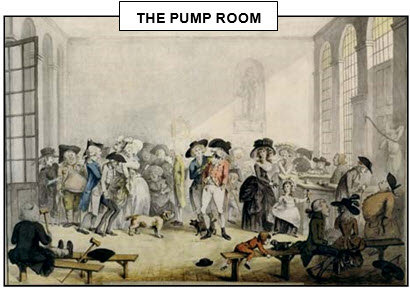
xxxxxThen, the streets having been cleared of beggars and thieves, a polished code of conduct was introduced whereby the affluent, refined members of society who visited the spa could spend a pleasure-filled day - taking the water in the morning, gossiping and flirting in the palatial Pump Room, promenading with style in the afternoon, and dancing with elegance at the evening balls, held in the newly constructed Assembly Halls. This social whirl, all done in the best possible taste, was supplemented by pleasures to titillate - “soft Musick” and ample opportunity for a spot of gambling. It is hardly surprising that, within a few years, elegant, fashionable Bath should become a Mecca for the wealthy. Aristocrats flocked from all over the country to take part in the social ritual, and to rub shoulders with anyone who was anyone in polite society. The Anglo-Irish writer Oliver Goldsmith aptly described Nash as “a man who for 50 years presided over the pleasures of a polite kingdom”.
xxxxxUnfortunately, Nash made the bulk of his not inconsiderable income from organising the gambling, so that when the Gaming Act of 1739 came in, banning such activity, he was badly affected. Thus by the time Gainsborough arrived in 1760, Nash was not only quite old, but also quite poor. He died two years later, surrounded by the grandeur and opulence he had done so much to create.
xxxxxThe English dandy Richard “Beau” Nash (1674-1762), who died two years after Gainsborough arrived in Bath, was the man responsible for making this spa city a highly fashionable resort for the pleasure-seeking aristocracy. Soon after his arrival in 1703 he set about cleaning up the city and building crescents of fine Georgian houses - mainly the work of the English architect John Wood the Elder. By the 1750s hundreds were visiting Bath to “take the waters”, promenade through the streets, dance the night away, and partake of less innocent pleasures, including gambling. To maintain their standing in society, aristocrats were obliged to be seen at this elegant, fashionable Mecca of wealth and refinement.


xxxxxAs a portraitist, he was skilful in capturing the likeness and character of his sitters, and he possessed a remarkable talent for creating around his figures a casual air of refinement and good taste. He achieved this, above all, by the use of fresh, cool colours thinly applied, a very good eye for elegant and fashionable clothing, and the choice of a natural, idyllic setting, be it a woodland glade or 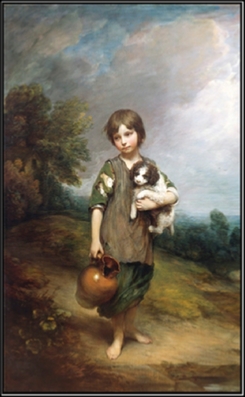 the extensive grounds of a family estate. Striking examples are, The Blue Boy (illustrated below), Mary, Countess Howe, and The Morning Walk (in the National Gallery, London). Viewed together, these portraits depict the hallmarks of a privileged society, composed, self-assured, and enjoying the pleasures of a comfortable life. Indeed, this aspect of his portraiture provides a social commentary on the life style and look of the English aristocracy in the 18th century. But not all his portraits were taken from within high society. A highly sensitive man, he also produced some charming, sympathetic studies - like
the extensive grounds of a family estate. Striking examples are, The Blue Boy (illustrated below), Mary, Countess Howe, and The Morning Walk (in the National Gallery, London). Viewed together, these portraits depict the hallmarks of a privileged society, composed, self-assured, and enjoying the pleasures of a comfortable life. Indeed, this aspect of his portraiture provides a social commentary on the life style and look of the English aristocracy in the 18th century. But not all his portraits were taken from within high society. A highly sensitive man, he also produced some charming, sympathetic studies - like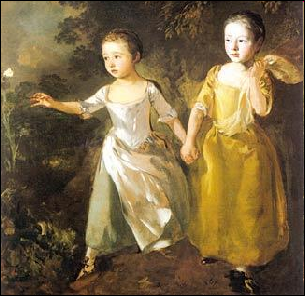 Painter’s Daughters Chasing a Butterfly (illustrated) - and he conjured up imaginative compositions reminiscent of the work of the Spanish painter Bartolomé Murillo, an artist whom he much admired. Dismissed as “fancy pictures” by Reynolds, these whimsical, gentle works depicted waifs and strays and rustic lovers in Arcadian landscapes. The best example of these is The Cottage Girl with Dog and Pitcher (illustrated above), a work which many feel is unequalled in its wistful charm.
Painter’s Daughters Chasing a Butterfly (illustrated) - and he conjured up imaginative compositions reminiscent of the work of the Spanish painter Bartolomé Murillo, an artist whom he much admired. Dismissed as “fancy pictures” by Reynolds, these whimsical, gentle works depicted waifs and strays and rustic lovers in Arcadian landscapes. The best example of these is The Cottage Girl with Dog and Pitcher (illustrated above), a work which many feel is unequalled in its wistful charm.
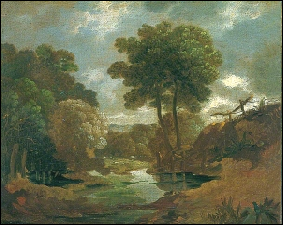 xxxxxIn his day, and even today, Gainsborough is principally known for his portraits but, in fact, he much preferred to paint landscapes, only concentrating on portraiture because the money was so good. Indeed, following the Dutch example, he was one of the first British artists to paint realistic rather than imaginative landscape scenes. The Harvest Wagon and The Market Cart are perhaps his best known works, but illustrated here is his Pool in the Woods. Forest scenes like these, or rough, broken countryside provide his usual subject matter. His Cornard Wood and The Watering Place can be seen in the National Gallery, London. In addition, a number of his portraits have landscape settings which can stand on their own merit. This is best seen in his early work Mr and Mrs Andrews (illustrated above), where the background of rolling farmland shares equal merit with the brilliant double portrait. His wooded landscapes clearly show the influence of the Flemish painter Peter Paul Rubens - whom he greatly admired. (Indeed, in The Harvest Wagon, the composition of the occupants of the cart is based on the Dutch artist’s group of figures in his Descent from the Cross.) In their turn, his own works anticipate the style of the two English artists Turner and Constable.
xxxxxIn his day, and even today, Gainsborough is principally known for his portraits but, in fact, he much preferred to paint landscapes, only concentrating on portraiture because the money was so good. Indeed, following the Dutch example, he was one of the first British artists to paint realistic rather than imaginative landscape scenes. The Harvest Wagon and The Market Cart are perhaps his best known works, but illustrated here is his Pool in the Woods. Forest scenes like these, or rough, broken countryside provide his usual subject matter. His Cornard Wood and The Watering Place can be seen in the National Gallery, London. In addition, a number of his portraits have landscape settings which can stand on their own merit. This is best seen in his early work Mr and Mrs Andrews (illustrated above), where the background of rolling farmland shares equal merit with the brilliant double portrait. His wooded landscapes clearly show the influence of the Flemish painter Peter Paul Rubens - whom he greatly admired. (Indeed, in The Harvest Wagon, the composition of the occupants of the cart is based on the Dutch artist’s group of figures in his Descent from the Cross.) In their turn, his own works anticipate the style of the two English artists Turner and Constable.
xxxxxGainsborough was one of the most versatile English painters, being accomplished in both portraiture and landscape. In addition, he left hundreds of etchings and drawings in a variety of mediums, the majority of them concerned with his love of landscape. The viewer might feel that his paintings in both genre are tinged with what has been described as a “poetic melancholy”, seen earlier, for example, in the works of the French rococo painter Watteau. His portraits and his woodland scenes sometimes appear too calm and too composed for comfort. The feeling of unease was justified. As we shall see, within a few years nearly the whole of Europe was to be alarmed by the French Revolution, and then engulfed by the Napoleonic Wars. Gainsborough escaped such trauma. He died a year before the 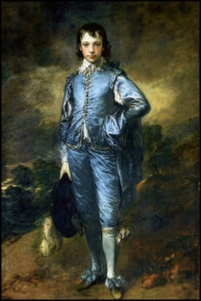 French Revolution broke out, and was buried in Kew churchyard.
French Revolution broke out, and was buried in Kew churchyard.
xxxxxIncidentally, the story goes that his portrait of The Blue Boy - clearly painted as a homage to Van Dyck - was given that colour to disprove a theory put forward by his rival, Joshua Reynolds, that blue should never be the predominant colour in a picture. Whether this story be true or not, it is a fact that Gainsborough made great use of greens and blues in his work. ......
xxxxx...... Whilst he and Reynolds were professional rivals over many years, both had respect for each other’s ability. Following the death of Gainsborough, Reynolds used his Fourteenth Discourse at the Royal Academy to pay tribute to his fellow artist.
xxxxxThe Welsh painter Richard Wilson (1714-82) started his career as a portrait artist. He was quite successful, producing portraits of the two sons of the Prince of Wales, and one of Flora Macdonald in 1747, but all this changed when he visited Italy three years later. There he came to appreciate the classical style of the French artist Claude Joseph Vernet, and was persuaded to turn his hand to landscape painting. He produced a number of fine works depicting the Roman countryside, and returned to London in 1756. Views of his homeland included the grandeur of Snowden and Cader Idris, whilst in England he painted a number of scenes in the London area, - such as Thames near Twickenham - together with works like the romantic ruin, The Keep of Okehampton Castle, and a series of paintings of Wilton House, in Wiltshire. Wilson was one of the first British landscape artists of importance and, like Gainsborough, his work had a marked influence on future landscape artists in England, especially Turner and Constable.
xxxxxA landscape artist of this time who, like Gainsborough, influenced the English artists Turner and Constable, was the Welsh painter Richard Wilson (1714-1782). Today he is regarded as one of the first British landscape artists of importance. Indeed, Turner regarded him as “the greatest genius who ever touched landscape.” It was during a visit to Italy in the early 1750s that, apart from meeting Joshua Reynolds in Rome, he struck up a friendship with the French artist Claude Joseph Vernet (1714-1789). His work was very much imitative of that of the 17th century French painter Claude Lorrain, and it was from him that Wilson first took on his classical style. And it was Vernet who persuaded Wilson to concentrate his efforts on landscape painting. As a result he picked up some lucrative commissions, producing dozens of paintings and sketches of the Roman countryside. He also made two trips to Naples at this time, where his work included a sketch of the crater of Mount Vesuvius. Paintings belonging to this period were Rome from the Villa Madama of 1753, and Rome: St. Peter’s and the Vatican from the Janiculum, completed in 1754.
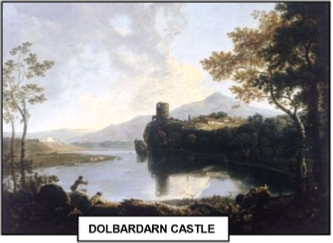 xxxxxWilson was born in the village of Penegoes in North Wales where his father was the rector. As a teenager he studied under Thomas Wright, a London portraitist, and in the early part of his career he achieved some success in producing society portraits, including the two young sons of the Prince of Wales. It was during this period that he painted his portrait of Flora Macdonald (of Bonnie Prince Charlie fame) soon after she was released from prison in 1747. His early works as a landscape artist included a pair of pictures for the new Foundling Hospital, donated under a charitable scheme organised by William Hogarth. One was of the hospital itself, and the companion piece was of St. George’s Hospital. It was soon after this that he went on his Grand Tour.
xxxxxWilson was born in the village of Penegoes in North Wales where his father was the rector. As a teenager he studied under Thomas Wright, a London portraitist, and in the early part of his career he achieved some success in producing society portraits, including the two young sons of the Prince of Wales. It was during this period that he painted his portrait of Flora Macdonald (of Bonnie Prince Charlie fame) soon after she was released from prison in 1747. His early works as a landscape artist included a pair of pictures for the new Foundling Hospital, donated under a charitable scheme organised by William Hogarth. One was of the hospital itself, and the companion piece was of St. George’s Hospital. It was soon after this that he went on his Grand Tour.
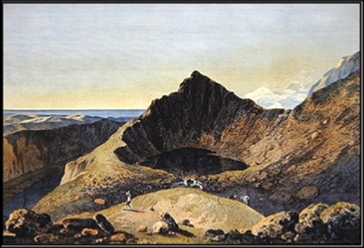 xxxxxAfter his long stay in Italy, where, as we have seen, he had already begun his career as a landscape artist, he returned to London in 1756 and settled in new and grand premises in Covent Garden. Becoming a founder member of the Society of Artists three years later, he was not short of work. Then in 1768 he was one of the 34 founder members of the Royal Academy, and entered a circle of friends which included the actor David Garrick and the two writers Samuel Johnson and Lawrence Sterne. At first he enjoyed a deal of success and his paintings of this period included his dramatic picture of the Welsh mountain Cader Idris (illustrated), produced around 1774 (now in the Tate Gallery, London) and his serene Snowden from Llyn Nantile. Imagination played a part in their composition, but in both he created a feeling of grandeur and spatial depth, obtained in large part by his clever handling of light. Among English landscapes are his Thames near Twickenham, his romantic ruin, The Keep of Okehampton Castle (Devon) and five views of Wilton House (Wiltshire) in which the composition and colouring are very reminiscent of the works of Claude Lorrain. (It was at Wilton House that Gainsborough saw and studied a collection of paintings by Van Dyck).
xxxxxAfter his long stay in Italy, where, as we have seen, he had already begun his career as a landscape artist, he returned to London in 1756 and settled in new and grand premises in Covent Garden. Becoming a founder member of the Society of Artists three years later, he was not short of work. Then in 1768 he was one of the 34 founder members of the Royal Academy, and entered a circle of friends which included the actor David Garrick and the two writers Samuel Johnson and Lawrence Sterne. At first he enjoyed a deal of success and his paintings of this period included his dramatic picture of the Welsh mountain Cader Idris (illustrated), produced around 1774 (now in the Tate Gallery, London) and his serene Snowden from Llyn Nantile. Imagination played a part in their composition, but in both he created a feeling of grandeur and spatial depth, obtained in large part by his clever handling of light. Among English landscapes are his Thames near Twickenham, his romantic ruin, The Keep of Okehampton Castle (Devon) and five views of Wilton House (Wiltshire) in which the composition and colouring are very reminiscent of the works of Claude Lorrain. (It was at Wilton House that Gainsborough saw and studied a collection of paintings by Van Dyck).
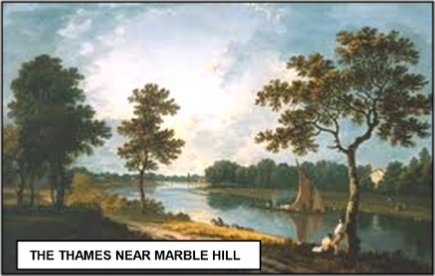 xxxxxTowards the end of the 1760s, however, Wilson began to lose some of his old patrons. Competitors with a lighter touch proved more popular than the somewhat brooding, classical style. And Wilson himself was, as someone put it, like an olive, “rough to the taste at first”. At one time he even quarrelled with the king for criticising two views of Kew Gardens which he had painted for him. To drown his sorrows he took to drink, and his work went further into decline. Towards the end of his life he struggled to make ends meet, sometimes lacking enough money to buy his materials. In 1776 he took the post of librarian at the Royal Academy to bring in a little money. Eventually he returned to Wales where relatives cared for him until his sudden death in 1782.
xxxxxTowards the end of the 1760s, however, Wilson began to lose some of his old patrons. Competitors with a lighter touch proved more popular than the somewhat brooding, classical style. And Wilson himself was, as someone put it, like an olive, “rough to the taste at first”. At one time he even quarrelled with the king for criticising two views of Kew Gardens which he had painted for him. To drown his sorrows he took to drink, and his work went further into decline. Towards the end of his life he struggled to make ends meet, sometimes lacking enough money to buy his materials. In 1776 he took the post of librarian at the Royal Academy to bring in a little money. Eventually he returned to Wales where relatives cared for him until his sudden death in 1782.
xxxxxAnother landscape artist worthy of note is the London-born John Robert Cozens (1752-97). Son of the water-colourist Alexander Cozens, he was inspired by visits to Switzerland and Italy, where he produced dramatic watercolour views of mountain scenery, often shrouded in mist and threatened by storm. These highly charged, romantic works, introducing as they did a new dimension to watercolour painting, had a long term influence on British landscape painters, and proved of particular value to the two great English masters of watercolour, Thomas Girtin and J.M.W. Turner.
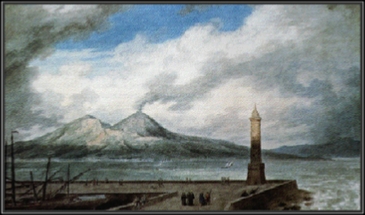 xxxxxWhilst on the subject of landscapes, mention must be made of the London-born artist John Robert Cozens (1752-1797), whose watercolours had a long term influence on British landscape painters. Son of the accomplished water-colourist Alexander Cozens, he found his inspiration and developed his unique style during two visits to the continent in the late 1770s and the early 1780s. These journeys took him to Switzerland and Italy where, taking as his main subjects the Alps and the Roman Campagna, he produced wild, haunting landscapes full of brooding mountains, swirling mist and gathering storm. Here shown is a view of Mount Vesuvius, produced in 1782.
xxxxxWhilst on the subject of landscapes, mention must be made of the London-born artist John Robert Cozens (1752-1797), whose watercolours had a long term influence on British landscape painters. Son of the accomplished water-colourist Alexander Cozens, he found his inspiration and developed his unique style during two visits to the continent in the late 1770s and the early 1780s. These journeys took him to Switzerland and Italy where, taking as his main subjects the Alps and the Roman Campagna, he produced wild, haunting landscapes full of brooding mountains, swirling mist and gathering storm. Here shown is a view of Mount Vesuvius, produced in 1782.
xxxxxShown below are three works from his travels in Italy (left to right): A Shepherd’s Hut between Naples and Portici, A ruined fort near Salerno, and Lake Nemi in the Lazio Region.
xxxxxThese highly-charged, imaginative and romantic works - achieved in the main by a subtle combination of grey, blue and green - marked a dramatic departure from the pastoral scenes hitherto associated with watercolour. This medium now became a more expressive, versatile vehicle and, as such, exercised a profound influence, above all, on Thomas Girtin and J.M.W. Turner, the two great masters of English watercolour. In the words of the English artist John Constable he was “the greatest genius that ever touched landscape”.
xxxxxSadly, Cozens became insane in 1793, and remained so for the remainder of his life. During his illness he was cared for by the London art patron Dr Thomas Monro, for whom both Girtin and Turner had worked as students.










 xxxxxThe career of the English painter Thomas Gainsborough took off with a vengeance soon after he settled down in the fashionable resort of Bath in 1760. Within a few years he was one of the country’s best known and admired portrait artists, rivaling the great English painter Joshua Reynolds for his flattering, elegant portrayal of members of the aristocracy -
xxxxxThe career of the English painter Thomas Gainsborough took off with a vengeance soon after he settled down in the fashionable resort of Bath in 1760. Within a few years he was one of the country’s best known and admired portrait artists, rivaling the great English painter Joshua Reynolds for his flattering, elegant portrayal of members of the aristocracy - Suffolk and worked at Sudbury and Ipswich for the next eleven years. Here he began to make a name for himself as a portrait artist, but there was not a great deal of money around and his output was somewhat modest. We are told that he could only charge 8 guineas for a “head”, and 15 for a “half-
Suffolk and worked at Sudbury and Ipswich for the next eleven years. Here he began to make a name for himself as a portrait artist, but there was not a great deal of money around and his output was somewhat modest. We are told that he could only charge 8 guineas for a “head”, and 15 for a “half-
 xxxxxTwo years after Gainsborough moved to Bath, the death occurred of the English dandy Richard “Beau” Nash (1674-
xxxxxTwo years after Gainsborough moved to Bath, the death occurred of the English dandy Richard “Beau” Nash (1674-


 the extensive grounds of a family estate. Striking examples are, The Blue Boy (illustrated below), Mary, Countess Howe, and The Morning Walk (in the National Gallery, London). Viewed together, these portraits depict the hallmarks of a privileged society, composed, self-
the extensive grounds of a family estate. Striking examples are, The Blue Boy (illustrated below), Mary, Countess Howe, and The Morning Walk (in the National Gallery, London). Viewed together, these portraits depict the hallmarks of a privileged society, composed, self- Painter’s Daughters Chasing a Butterfly (
Painter’s Daughters Chasing a Butterfly ( xxxxxIn his day, and even today, Gainsborough is principally known for his portraits but, in fact, he much preferred to paint landscapes, only concentrating on portraiture because the money was so good. Indeed, following the Dutch example, he was one of the first British artists to paint realistic rather than imaginative landscape scenes. The Harvest Wagon and The Market Cart are perhaps his best known works, but illustrated here is his Pool in the Woods. Forest scenes like these, or rough, broken countryside provide his usual subject matter. His Cornard Wood and The Watering Place can be seen in the National Gallery, London. In addition, a number of his portraits have landscape settings which can stand on their own merit. This is best seen in his early work Mr and Mrs Andrews (illustrated above), where the background of rolling farmland shares equal merit with the brilliant double portrait. His wooded landscapes clearly show the influence of the Flemish painter Peter Paul Rubens -
xxxxxIn his day, and even today, Gainsborough is principally known for his portraits but, in fact, he much preferred to paint landscapes, only concentrating on portraiture because the money was so good. Indeed, following the Dutch example, he was one of the first British artists to paint realistic rather than imaginative landscape scenes. The Harvest Wagon and The Market Cart are perhaps his best known works, but illustrated here is his Pool in the Woods. Forest scenes like these, or rough, broken countryside provide his usual subject matter. His Cornard Wood and The Watering Place can be seen in the National Gallery, London. In addition, a number of his portraits have landscape settings which can stand on their own merit. This is best seen in his early work Mr and Mrs Andrews (illustrated above), where the background of rolling farmland shares equal merit with the brilliant double portrait. His wooded landscapes clearly show the influence of the Flemish painter Peter Paul Rubens - French Revolution broke out, and was buried in Kew churchyard.
French Revolution broke out, and was buried in Kew churchyard. xxxxxWilson was born in the village of Penegoes in North Wales where his father was the rector. As a teenager he studied under Thomas Wright, a London portraitist, and in the early part of his career he achieved some success in producing society portraits, including the two young sons of the Prince of Wales. It was during this period that he painted his portrait of Flora Macdonald (of Bonnie Prince Charlie fame) soon after she was released from prison in 1747. His early works as a landscape artist included a pair of pictures for the new Foundling Hospital, donated under a charitable scheme organised by William Hogarth. One was of the hospital itself, and the companion piece was of St. George’s Hospital. It was soon after this that he went on his Grand Tour.
xxxxxWilson was born in the village of Penegoes in North Wales where his father was the rector. As a teenager he studied under Thomas Wright, a London portraitist, and in the early part of his career he achieved some success in producing society portraits, including the two young sons of the Prince of Wales. It was during this period that he painted his portrait of Flora Macdonald (of Bonnie Prince Charlie fame) soon after she was released from prison in 1747. His early works as a landscape artist included a pair of pictures for the new Foundling Hospital, donated under a charitable scheme organised by William Hogarth. One was of the hospital itself, and the companion piece was of St. George’s Hospital. It was soon after this that he went on his Grand Tour.  xxxxxAfter his long stay in Italy, where, as we have seen, he had already begun his career as a landscape artist, he returned to London in 1756 and settled in new and grand premises in Covent Garden. Becoming a founder member of the Society of Artists three years later, he was not short of work. Then in 1768 he was one of the 34 founder members of the Royal Academy, and entered a circle of friends which included the actor David Garrick and the two writers Samuel Johnson and Lawrence Sterne. At first he enjoyed a deal of success and his paintings of this period included his dramatic picture of the Welsh mountain Cader Idris (illustrated), produced around 1774 (now in the Tate Gallery, London) and his serene Snowden from Llyn Nantile. Imagination played a part in their composition, but in both he created a feeling of grandeur and spatial depth, obtained in large part by his clever handling of light. Among English landscapes are his Thames near Twickenham, his romantic ruin, The Keep of Okehampton Castle (Devon) and five views of Wilton House (Wiltshire) in which the composition and colouring are very reminiscent of the works of Claude Lorrain. (It was at Wilton House that Gainsborough saw and studied a collection of paintings by Van Dyck).
xxxxxAfter his long stay in Italy, where, as we have seen, he had already begun his career as a landscape artist, he returned to London in 1756 and settled in new and grand premises in Covent Garden. Becoming a founder member of the Society of Artists three years later, he was not short of work. Then in 1768 he was one of the 34 founder members of the Royal Academy, and entered a circle of friends which included the actor David Garrick and the two writers Samuel Johnson and Lawrence Sterne. At first he enjoyed a deal of success and his paintings of this period included his dramatic picture of the Welsh mountain Cader Idris (illustrated), produced around 1774 (now in the Tate Gallery, London) and his serene Snowden from Llyn Nantile. Imagination played a part in their composition, but in both he created a feeling of grandeur and spatial depth, obtained in large part by his clever handling of light. Among English landscapes are his Thames near Twickenham, his romantic ruin, The Keep of Okehampton Castle (Devon) and five views of Wilton House (Wiltshire) in which the composition and colouring are very reminiscent of the works of Claude Lorrain. (It was at Wilton House that Gainsborough saw and studied a collection of paintings by Van Dyck).  xxxxxTowards the end of the 1760s, however, Wilson began to lose some of his old patrons. Competitors with a lighter touch proved more popular than the somewhat brooding, classical style. And Wilson himself was, as someone put it, like an olive, “rough to the taste at first”. At one time he even quarrelled with the king for criticising two views of Kew Gardens which he had painted for him. To drown his sorrows he took to drink, and his work went further into decline. Towards the end of his life he struggled to make ends meet, sometimes lacking enough money to buy his materials. In 1776 he took the post of librarian at the Royal Academy to bring in a little money. Eventually he returned to Wales where relatives cared for him until his sudden death in 1782.
xxxxxTowards the end of the 1760s, however, Wilson began to lose some of his old patrons. Competitors with a lighter touch proved more popular than the somewhat brooding, classical style. And Wilson himself was, as someone put it, like an olive, “rough to the taste at first”. At one time he even quarrelled with the king for criticising two views of Kew Gardens which he had painted for him. To drown his sorrows he took to drink, and his work went further into decline. Towards the end of his life he struggled to make ends meet, sometimes lacking enough money to buy his materials. In 1776 he took the post of librarian at the Royal Academy to bring in a little money. Eventually he returned to Wales where relatives cared for him until his sudden death in 1782. xxxxxWhilst on the subject of landscapes, mention must be made of the London-
xxxxxWhilst on the subject of landscapes, mention must be made of the London-





